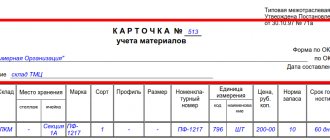Every year there are significant changes in legislation regarding the accounting of income and revenue of enterprises. According to recent changes in legislation, the concept of revenue now refers to the gross receipts of economic benefits in the normal course of business of an enterprise, leading directly to an increase in capital. In addition, deposit accounts from investors or other persons should also be included in revenue. This definition, in connection with the new changes, corresponds to the definition of income, and all documents on this concept are enshrined in PBU 9/99 in the section “Income of the organization.”
PBU 9/99 establishes rules for the formation in accounting of a complete list of information on the income of a commercial organization (except for credit and insurance companies), which is a full-fledged legal entity in accordance with the rules of the legislation of the Russian Federation. For non-profit organizations, in accordance with this PBU, only income from entrepreneurial and other types of earnings of the enterprise is recognized.
Understanding PBU 9/99 is perhaps even more difficult than understanding how to create a business plan, but we will still try to do it.
How is the concept of income formed in accordance with PBU 9/99?
Depending on the definition of this concept, the reflection of income in accounting reports, as well as their further taxation, largely depends. According to PBU, an organization’s income is defined as an increase in economic benefits as a result of the gradual receipt of assets (property and cash) and the systematic repayment of all liabilities leading to a decrease in the organization’s capital. However, income cannot be understood as the contributions of participants who form the organization’s fund thanks to the property of the owners.
For accounting purposes, the organization’s income does not recognize all kinds of receipts from legal entities and individuals not related to the enterprise. Thus, the report does not take into account:
1) The amount of value added taxes, various types of excise taxes, sales taxes, export duties and other types of similar mandatory payments; 2) The amount of commission on contracts, agency and similar contracts in favor of the committee; 3) The amount received in the preliminary stages of payment for products, works, goods and services; 4) The amount of the advance payment for products, goods, services, etc.; 5) The amount of the deposit received and the value of only the property that is pledged, if the agreement provides for the transfer of all types of pledged property for the use of the pledgee; 6) The amount received from borrowers when repaying loans or borrowings provided to borrowers.
Thus, when preparing accounting records, not all types of income are taken into account when planning reports. Moreover, revenue under the new legislation can be calculated using different methods.
We predict financial results
If you want to calculate revenue from services provided, then it should be determined depending on the predictability of the financial results of transactions:
1. By the method of recognizing revenue as it is developed and ready: if the results of a transaction can be reliably assessed (the amounts of revenue and costs are reliably planned, and the degree of completion of transactions is reliably determined, in addition, there is a likelihood of obtaining additional economic benefits), then the amount of revenue is determined taking into account all stages of development and completion of transactions by reporting dates.
2. Recognition of the amount of revenue to the extent of reducing all costs by reimbursing them to the creditor: when the results of the transaction cannot be calculated in any way, and revenue is recognized based on the amount of reimbursable expenses.
Such approaches to revenue recognition for accounting for a certain period of time make it possible to reflect in the financial statements the amount of income that will actually be received in the near future. Thus, the amount of receivables is now not taken into account, which may or may not be real upon collection.
In the sections of the rules “organizational income - PBU 9/99”, for the first time in accounting, specific conditions are formulated for the recognition of income from ordinary activities of the enterprise. This type of income (revenue) is recognized when preparing accounting records only if the following conditions and criteria are met:
a) the enterprise has full rights to receive this type of revenue, which arises from specific contracts or is otherwise confirmed in an appropriate manner; b) the amount of revenue can be accurately determined; c) during the calculation process there is confidence that as a result of specific transactions there will be an increase in the entire list of economic benefits of this organization. Confirmation of this factor may be a situation where the organization received assets as payment, or there is no uncertainty regarding the possibility of receiving this asset; d) ownership rights (possession, use and disposal) of products or goods have passed from the organization to a specific buyer, or the work has been accepted at one time by the customer (i.e. the service has been provided to the client).
I. General provisions1. These Regulations establish the rules for the formation in accounting of information on the income of commercial organizations (except for credit and insurance organizations) that are legal entities under the legislation of the Russian Federation. In relation to these Regulations, non-profit organizations (except for budgetary institutions) recognize income from business and other activities. (as amended by Order of the Ministry of Finance of the Russian Federation dated December 30, 1999 N 107n)
2. An organization’s income is recognized as an increase in economic benefits as a result of the receipt of assets (cash, other property) and (or) repayment of liabilities, leading to an increase in the capital of this organization, with the exception of contributions from participants (owners of property).
3. For the purposes of these Regulations, the following receipts from other legal entities and individuals are not recognized as income of the organization: amounts of value added tax, excise taxes, sales tax, export duties and other similar mandatory payments; under commission agreements, agency and other similar agreements in favor of the principal, principal, etc.; in advance payment for products, goods, works, services; advances in payment for products, goods, works, services; deposit; as a pledge, if the agreement provides for the transfer of the pledged property to the pledgee; to repay a loan granted to the borrower.
4. The income of the organization, depending on its nature, conditions for receipt and areas of activity of the organization, is divided into: a) income from ordinary activities; b) other income.
For the purposes of these Regulations, income other than income from ordinary activities is considered other income. For accounting purposes, the organization independently recognizes receipts as income from ordinary activities or other income based on the requirements of these Regulations, the nature of its activities, the type of income and the conditions for their receipt.
II. Income from ordinary activities
5. Income from ordinary activities is revenue from the sale of products and goods, receipts associated with the performance of work, provision of services (hereinafter referred to as revenue). In organizations whose subject of activity is the provision for a fee for temporary use (temporary possession and use) of their assets under a lease agreement, revenue is considered to be receipts the receipt of which is associated with this activity (rent). In organizations whose subject of activity is the provision for a fee of rights arising from patents for inventions, industrial designs and other types of intellectual property, revenue is considered to be receipts the receipt of which is associated with this activity (license payments (including royalties) for the use of intellectual property). In organizations whose subject of activity is participation in the authorized capital of other organizations, revenue is considered to be receipts of which are associated with this activity. Income received by an organization from provision for a fee for temporary use (temporary possession and use) of its assets, rights arising from patents for inventions, industrial designs and other types of intellectual property, and from participation in the authorized capital of other organizations, when this is not the subject of activities of the organization are classified as other income.
6. Revenue is accepted for accounting in an amount calculated in monetary terms equal to the amount of receipt of cash and other property and (or) the amount of accounts receivable (taking into account the provisions of paragraph 3 of these Regulations). If the amount of receipt covers only part of the revenue, then the revenue accepted for accounting is determined as the sum of receipt and receivables (in the part not covered by receipt). 6.1. The amount of receipts and (or) receivables is determined based on the price established by the agreement between the organization and the buyer (customer) or user of the organization’s assets. If the price is not provided for in the contract and cannot be established based on the terms of the contract, then to determine the amount of receipts and (or) receivables, the price at which, in comparable circumstances, the organization usually determines revenue in relation to similar products (goods, works, services) is accepted. or providing for temporary use (temporary possession and use) of similar assets. 6.2. When selling products and goods, performing work, providing services on the terms of a commercial loan provided in the form of deferred and installment payment, the proceeds are accepted for accounting in the full amount of receivables. 6.3. The amount of receipts and (or) receivables under contracts providing for the fulfillment of obligations (payment) not in cash is accepted for accounting at the cost of goods (valuables) received or to be received by the organization. The cost of goods (valuables) received or to be received by an organization is established based on the price at which, in comparable circumstances, the organization usually determines the cost of similar goods (valuables). If it is impossible to determine the value of goods (valuables) received by the organization, the amount of receipts and (or) receivables is determined by the value of the products (goods) transferred or to be transferred by the organization. The cost of products (goods) transferred or to be transferred by an organization is established based on the price at which, in comparable circumstances, the organization usually determines revenue in relation to similar products (goods). 6.4. In the event of a change in the obligation under the contract, the initial amount of receipts and (or) receivables is adjusted based on the value of the asset to be received by the organization. The value of an asset to be received by an organization is determined based on the price at which, in comparable circumstances, the organization usually determines the value of similar assets. 6.5. The amount of receipts and (or) receivables is determined taking into account all discounts (mark-ups) provided to the organization in accordance with the agreement. 6.6. Excluded - Order of the Ministry of Finance of the Russian Federation dated November 27, 2006 No. 156n. 6.7. When provisions for doubtful debts are formed in accordance with the accounting rules, the amount of revenue does not change.
III. Other supply
7. Other income is: receipts associated with the provision for a fee for temporary use (temporary possession and use) of the organization’s assets (subject to the provisions of paragraph 5 of these Regulations); (as amended by Order of the Ministry of Finance of the Russian Federation dated March 30, 2001 N 27n) receipts related to the provision for a fee of rights arising from patents for inventions, industrial designs and other types of intellectual property (taking into account the provisions of paragraph 5 of these Regulations); (as amended by Order of the Ministry of Finance of the Russian Federation dated March 30, 2001 N 27n) income related to participation in the authorized capitals of other organizations (including interest and other income on securities) (subject to the provisions of paragraph 5 of these Regulations); (as amended by Order of the Ministry of Finance of the Russian Federation dated March 30, 2001 N 27n) profit received by the organization as a result of joint activities (under a simple partnership agreement); proceeds from the sale of fixed assets and other assets other than cash (except foreign currency), products, goods; interest received for providing the organization’s funds for use, as well as interest for the bank’s use of funds held in the organization’s account with this bank.
8. Excluded - Order of the Ministry of Finance of the Russian Federation dated September 18, 2006 No. 116n.
9. Other income is considered to be income arising as a consequence of emergency circumstances of economic activity (natural disaster, fire, accident, nationalization, etc.): insurance compensation, the cost of material assets remaining from the write-off of assets unsuitable for restoration and further use, etc. .P.
10. For accounting purposes, the amount of other income is determined in the following order: 10.1. The amount of proceeds from the sale of fixed assets and other assets other than cash (except foreign currency), products, goods, as well as the amount of interest received for providing the organization’s funds for use, and income from participation in the authorized capitals of other organizations (when is not the subject of the organization’s activities) is determined in a manner similar to that provided for in paragraph 6 of these Regulations. 10.2. Fines, penalties, penalties for violations of contract terms, as well as compensation for losses caused to the organization are accepted for accounting in amounts awarded by the court or recognized by the debtor. 10.3. Assets received free of charge are accepted for accounting at market value. The market value of assets received free of charge is determined by the organization on the basis of prices in force on the date of their acceptance for accounting for this or a similar type of asset. Data on prices valid on the date of acceptance for accounting must be confirmed by documents or through an examination. 10.4. Accounts payable for which the statute of limitations has expired are included in the organization's income in the amount in which this debt was reflected in the organization's accounting records. 10.5. The amounts of revaluation of assets are determined in accordance with the rules established for the revaluation of assets. 10.6. Other income is accepted for accounting in actual amounts.
11. Other receipts are subject to credit to the organization’s profit and loss account, except in cases where the accounting rules establish a different procedure.
IV. Revenue recognition
12. Revenue is recognized in accounting if the following conditions are met: a) the organization has the right to receive this revenue arising from a specific agreement or confirmed in another appropriate manner; b) the amount of revenue can be determined; c) there is confidence that as a result of a particular transaction there will be an increase in the economic benefits of the organization. Confidence that a particular transaction will result in an increase in the economic benefits of the organization exists when the organization received an asset in payment or there is no uncertainty regarding the receipt of the asset; d) the right of ownership (possession, use and disposal) of the product (goods) has passed from the organization to the buyer or the work has been accepted by the customer (service provided); e) the expenses that have been incurred or will be incurred in connection with this operation can be determined. If at least one of the above conditions is not met in relation to cash and other assets received by the organization as payment, then the organization’s accounting records recognize accounts payable, not revenue. To recognize in accounting revenues from the provision for a fee for temporary use (temporary possession and use) of one’s assets, rights arising from patents for inventions, industrial designs and other types of intellectual property and from participation in the authorized capital of other organizations, must be simultaneously observed the conditions defined in subparagraphs “a”, “b” and “c” of this paragraph.
13. An organization may recognize in accounting revenue from the performance of work, provision of services, sale of products with a long manufacturing cycle as the work, service, product is ready or upon completion of the work, provision of service, or manufacture of products in general. Revenue from performing specific work, providing a specific service, or selling a specific product is recognized in accounting as it is ready, if it is possible to determine the readiness of the work, service, or product. In relation to work, provision of services, and manufacture of products that are different in nature and conditions, an organization may simultaneously apply different methods of revenue recognition provided for in this paragraph in one reporting period.
14. If the amount of revenue from the sale of products, performance of work, provision of services cannot be determined, then it is accepted for accounting in the amount of expenses recognized in accounting for the manufacture of these products, performance of this work, provision of this service, which will subsequently be reimbursed to the organization .
15. Rent and license payments for the use of intellectual property (when this is not the subject of the organization’s activities) are recognized in accounting based on the assumption of temporary certainty of the facts of economic activity and the terms of the relevant agreement. Rent and license payments for the use of intellectual property (when this is not the subject of the organization’s activities) are recognized in accounting in a manner similar to that provided for in paragraph 12 of these Regulations.
16. Other receipts are recognized in accounting in the following order: receipts from the sale of fixed assets and other assets other than cash (except foreign currency), products, goods, as well as interest received for the provision of funds to the organization for use, and income from participation in the authorized capitals of other organizations (when this is not the subject of the organization’s activities) - in a manner similar to that provided for in paragraph 12 of these Regulations. In this case, for accounting purposes, interest is accrued for each expired reporting period in accordance with the terms of the agreement; fines, penalties, penalties for violation of the terms of contracts, as well as compensation for losses caused to the organization - in the reporting period in which the court made a decision to collect them or they were recognized as a debtor; the amount of accounts payable and depository debt for which the limitation period has expired - in the reporting period in which the limitation period has expired; the amount of revaluation of assets - in the reporting period to which the date as of which the revaluation was made; other receipts - as they are formed (identified).
V. Disclosure of information in financial statements
17. As part of the information on the accounting policy of the organization in the financial statements, at least the following information is subject to disclosure: a) on the procedure for recognizing the organization’s revenue; b) on the method of determining the readiness of work, services, products, revenue from the implementation, provision, sale of which is recognized as readiness.
18. In the profit and loss statement, the organization’s income for the reporting period is reflected with a division into revenue and other income. 18.1. Revenue, other income (revenue from the sale of products (goods), revenue from the performance of work (provision of services), etc.), amounting to five or more percent of the organization’s total income for the reporting period, are shown for each type separately. 18.2. Other income may be shown in the income statement less expenses related to these incomes when: a) the relevant accounting rules provide for or do not prohibit such recognition of income; b) income and related expenses arising as a result of the same or similar fact of economic activity (for example, the provision of temporary use (temporary possession and use) of its assets) are not significant for characterizing the financial position of the organization.
19. With regard to revenue received as a result of the execution of contracts providing for the fulfillment of obligations (payment) in non-monetary means, at least the following information is subject to disclosure: a) the total number of organizations with which these contracts are carried out, indicating the organizations that account for the bulk of such revenue; b) the share of revenue received under these agreements with related organizations; c) a method for determining the cost of products (goods) transferred by the organization.
20. Other income of the organization for the reporting period, which, in accordance with the accounting rules, are not credited to the profit and loss account, are subject to disclosure in the financial statements separately.
21. The structure of accounting should ensure the possibility of disclosing information about the organization’s income in the context of current, investment and financial activities.





